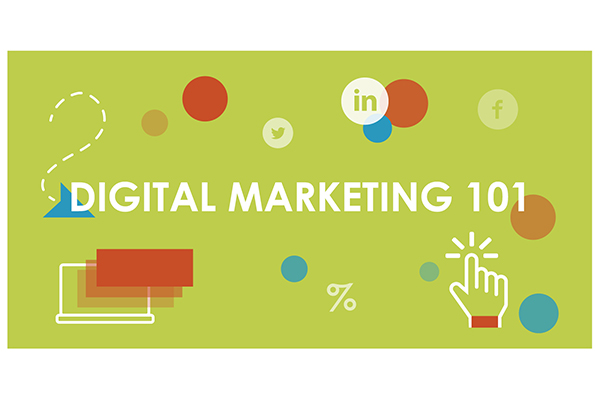Digital Marketing 101: The Fundamentals
Digital marketing is marketing online. It encompasses all engagement efforts and marketing through online media channels. In this Digital Marketing 101 guide, we’ll show you how businesses use Digital Marketing to get found, get leads, and convert those leads to sales.
When looking at digital marketing today, we find only a few buckets:

- Your website (inbound marketing)
- Search engine marketing (SEM)
- Search Engine Optimization (SEO)
- Pay-Per-Click advertising (PPC)
- Remarketing
- Marketing automation – email/SMS
- Social media
- Video
YOUR WEBSITE:
Think of your business as a building; your website is the foundation. Without a well thought-out and sturdy foundation, your building will most-likely topple. We’ll argue that it is the most critical asset you have for your marketing campaigns. A well-built website will not only educate your customers and generate new business; it will also help you validate your marketing efforts with online tracking you build into the site.
First, you need a strong foundation. Second, your foundation needs to be successful; here are a few things to keep in mind:
- SPEED – Think about any website you’ve been to that’s slow to load or struggles to load. How much time do you give it before going for the back button? According to Google: The time it takes the average mobile landing page to load fully is twenty-two seconds. However, research also indicates that fifty-three percent of people will leave a mobile page if it takes longer than three seconds to load. (1)
- SECURITY – Ever wonder what those letters are at the beginning of a URL? HTTPS or HTTP? It means Hyper Text Transfer Protocol and the “S” stands for Secure (glad you asked, I know). Internet users today are informed. What that can mean is they are much more wary of visiting unsecured websites. Data breaches are at an all-time high, and there are no signs of this slowing down—your website visitors know this. If your collecting data about users anywhere on your website (even if it’s only phone numbers and emails) it needs to be secure. Any site that wants to rank and show up in search results needs to be protected; It’s a factor.
- MOBILE – We are all connected. Think about it. How many times a day do you check your phone? We carry it with us most of the day. Websites optimized for mobile (aka mobile responsive) are much more likely to be served in SERP results (SERP you say? Eh Mike? Yea it’s not a condiment it just stands for Search Engine Results Page, sadly, not very delicious). Google awards websites which are mobile optimized, I’m sure Google sees the trends are moving away from the computer and laptop and more to mobile. Google is all about satisfying its users and having mobile-optimized results for mobile users is a no-brainer.
- USER EXPERIENCE – As your foundation, your website serves as the very top of your marketing funnel. You want it to be a functional funnel. You need to be collecting user information and utilizing that information to sell. A user will not want to engage with a site that doesn’t meet their needs. If your website isn’t easily navigable, or there are long click-paths to get users where they need to go, you may lose out on traffic, unique visits, and have a higher bounce rate. All of this will affect your quality in the eyes of Google. Remember, the more top quality the website; the more Google will show it off to people looking for relevant content.
- SEO – That leads us to Search Engine Optimization (SEO). You want users to find you, and SEO is the way to go when it comes to being found Organically. From keywords to semantics, it’s a dynamic world, read on below to learn more.
SEARCH ENGINE MARKETING (SEM):
How do people find your website? Simple, 89.95 percent of the time it’s through Google and to a lesser (much lesser) extent, other search engines like Bing (3.99 percent of the time), Yahoo! (2.84 percent) and others (2). Here, let us break it down so you can get a better idea:

Search engine marketing (SEM) boils down to a multitude of marketing methods and tactics designed to make your company own the entire search engine results page for a set of questions, phrases, and keywords (in an ideal situation). There are two (well three) main ways to do this: search engine optimization (SEO) and with paid search ads (PPC) (the Google Display Network counts, too, but not for every segment or market).
SEARCH ENGINE OPTIMIZATION (SEO):

How far down do you go on a page during a search? Most of the time you click that very first listing, am I right? The statistics show that you’re over thirty-three percent more likely to click the first position than any other listing on a search results page (3). So how do you earn that first position?
Simple, with SEO.
 SEO is only one part of SEM; it’s the process of finding the right keywords and phrases you want to rank for. It’s getting those keywords and phrases onto the backend of your website in a way that’s easily crawlable by the “bots” that index your site. Additionally, it’s getting the frontend of your website to say the same thing, but in a way, a human can easily read and understand. A tricky balance that takes strategy and testing to find what works for your segment and market.
SEO is only one part of SEM; it’s the process of finding the right keywords and phrases you want to rank for. It’s getting those keywords and phrases onto the backend of your website in a way that’s easily crawlable by the “bots” that index your site. Additionally, it’s getting the frontend of your website to say the same thing, but in a way, a human can easily read and understand. A tricky balance that takes strategy and testing to find what works for your segment and market.
When looking at search engines (like Google, Bing, and Yahoo!), here’s how they function; search engines use “bots” which are strings of code that scan your site looking at the overall structure, words, pictures, and even the words in the URL. They compile this information and recall it when spitting out search results for users. Search engines try to show the most relevant results using several different factors.
This causes a problem: We want our pages to be engaging for the user. So how the heck do we make robots happy, too? Well, you speak their language, HTML that is. When creating a good SEO strategy, you must be cognizant of how these scans function. Robots cannot read the words on the site; they can’t “see” the pictures either. Having the correct SEO structure ensures crawlers have all the information about your website and content in a language they understand.
Google has confirmed its crawlers utilize more than 200 ranking signals when determining organic page rankings, here are the top ten:
- Secured sites (HTTPS vs. HTTP)
- Mobile-friendly websites
- Page speed
- Schema markup
- Webpage content quality
- Webpage content length
- Social and local signals
- Quality backlinks
- Optimized images
- Domain age
Let’s take a high-level look below:
Secured sites (HTTPS vs. HTTP)
Do you have an SSL certificate on your website? Do you know what that even means? If not, you probably won’t have one on your website, which by 2019 standards is a huge no-no. Typically, your hosting company can provide one. You purchase an SSL certificate to use on your website; sending all traffic through a secure socket layer preventing attackers from injecting malware and other viruses into your site which could harm unsuspecting users and be a detriment to your rankings. Google’s Chrome Browser now warns users if they are on a site which has no SSL certificate.
Mobile-friendly websites
How does your website look on a mobile device? Is it mobile-responsive? Is it FAST on mobile devices? Your website should be dynamic and responsive to different screen sizes. Having the correct website architecture ensures your users can navigate your site with ease, no matter how they are viewing it. Mobile-first indexing means sites optimized for mobile are shown first in search results.
Page speed
Pretty straightforward here, the faster your page loads – the happier and more engaged (noticing a trend here yet?) your user will be, and search engines will rank you better.
Schema markup
Ok, now we’re cooking with more exotic SEO spices! Schema markup is code on your back-end, which allows search engines to return more relevant and informative results. Allowing you to create rich-snippets and feature more related information in a search result. Schema enables search engines to understand and serve your data better, not just read what it says.
Webpage content quality
Are you the expert or thought leader in your vertical? Prove it! Have engaging content that the community will relate to and want to share. Again, having relevant, engaging content will get you shared around the web. Earning you inbound links and awarding your page with “Page Authority.”
Webpage content length
Here is a tricky one. Nowhere does Google say there is a minimum. However, data shows that the more content on a page, the better opportunity to rank. Google’s algorithm has changed a ton over the last year or two. We used to focus a lot of energy on keyword density. Now, Google penalizes you for too many keywords. The most effective way to create content for your website today is to develop copy that engages your users. Use your keyword, but do so appropriately and use synonyms and other descriptors to say what you want.
Social and local signals
Social and local signals enhance your SEO. You can expect increased online visibility to your website, including more traffic. On top of that, having a strong social and local presence increases your authority and brand recognition. It helps you have a more broad distribution of content that has a longer lifespan. Lastly, it improves your local SEO. By having a robust social presence, you will have more results on search engine results pages, too.
Quality backlinks
Backlinks are the lifeblood of your website. The more quality backlinks you have, the better. The key here is quality. When other, highly-reputable websites link back to yours, Google awards you with some of their authority. The more reputable sites that link back to you, the more trustworthy your site appears to search engines. PageRank is how your links are “scored” — one of the more notable algorithms that brought Google fame. PageRank looks at how many links you have and their quality. In 2019, there’s no room for spammy backlinks. Only seek quality links, and you’ll be good!
Optimized images
They say a picture is worth a thousand words. Well, not to the bots that index your site. To them, it’s only a file with a name and filetype. Search engines have a hard time making sense of them.
Here’s a guide on how to optimize images for your website:
- Reduce the file size. Having compressed images helps your page load faster – improving page rankings!
- Having a filename with your keywords is essential, include keywords you are attempting to rank for
- Add a caption; this helps users find what they are looking for
- Alt tags are a piece of code you can edit to help search engines understand the image and index it better
- Include a title; this provides additional information to improve the user experience
PAY-PER-CLICK ADVERTISING (PPC):
When you search for something, what do you almost always see first? Paid Ads! On average, the top half of a search results page will be paid results. There are a few instances where this might not be true, like for some home services, for example. In most cases, however, you’ll run into paid ads. According to smartinsights.com, these positions earn thirty-three percent of the clicks the FIRST time. (3)

So how does it work? Creating a search ad is like going to an auction. Search engines use these pools of keyword ads to show to users based on their search. The more relevant your advertisement, the better chance you have at being shown to the user. On top of that, you can always bid higher than your competition to be at the top of the results page almost every time.
What that means in terms of return on investment is this: on average, businesses can expect to earn two dollars for every dollar spent. Here at DRPM, we build campaigns that can achieve five to ten TIMES that amount! Yes, we have campaigns with $10, $20, and even higher ROI rates per dollar spent.

REMARKETING:
You know when you’ve been checking out something you want online, then it starts following you around the internet? That’s called remarketing!
Here’s how it works: when a user lands on your site, a few lines of code get stored on the user’s browser; these are called cookies. These cookies live in the cache of users browsers (a temporary storage area for internet files). Depending on the settings, these can stay active for hours to a year or more. Cookies store tiny bits of information about your browsing without giving out any personal, identifiable information. After the cookied user leaves your website, the ad network tracks when they land on another. Once they do, bam! Your ad shows up. Remarketing is quite effective. Over seventy percent of users click through to convert. (4)

Remarketing and ad targeting is available on over ninety percent of the web. That includes social platforms like Facebook, LinkedIn, and more!
EMAIL MARKETING AND MARKETING AUTOMATION:
Are you one to sign up for promotional emails from your favorite businesses? Well, you’re not alone. Email marketing has extremely high ROI rates when running correctly.
Think about this:
- What’s one of the first things you check in the morning? For sixty-six percent of business people, that would be email (5)
- When it comes to weekly emails, sixty-one percent of consumers are interested, and twenty-eight percent would like emails to arrive even more frequently (6)
- For email marketing, you can expect an average of forty-four dollars return for every dollar spent! That’s right, a 4,400 percent ROI. Amazing! (6)
Now, marketing automation is not the same thing. Marketing automation is a blanket term and can include any form of messaging that is triggered automatically. From email to text messages, social media, and more, you can automate almost any message.
For example, A user on your site signs up for your email list. That info goes into a database you manage which then sends emails automatically. Depending on your strategy, this can happen once, or regularly. With proper marketing automation, you’ll be ready for success and amazing ROI with little effort and maximum gains!
SOCIAL MEDIA MARKETING (SMM):
Marketing on social platforms is a must. Why? Seventy percent of consumers expect an organization to have a social presence. (7) Furthermore, seventeen percent actively seek out organizations when looking for information about your business. (7)

For social media, these are the top platforms:
Here’s something to consider, since not all platforms are created equal. You should never have more than four social platforms at once unless you have a whole marketing team. Without a team you won’t have enough time to manage them all effectively. Additionally, some platforms are better for specific segments than others. You wouldn’t run a LinkedIn campaign for a consumer good, for example.
Now for the bad news: Social media is trending down, so only posting organically will no longer work. As more and more business attempt to reach their audience members and more and more social platforms develop, we lose the reach and frequency, we once had. To be successful today, you need to enhance your organic presence with paid social strategies as well. Otherwise, you will get lost in all the other noise and options demanding your user’s attention.
VIDEO MARKETING:
You may hear this more and more often these days: video is king! Why? It’s incredibly effective! On top of that, most of us now days have the attention span of a squirrel; anything to keep us engaged is a real winner.
Here are some stats which prove how accurate that statement is:
- You’re fifty times more likely to gain organic page ranks from Google with video compared to text (7)
- Fifty percent of users who watch videos say it helps them make informed purchases (7)
- With videos, users are sixty-four percent more likely to make a purchase and videos help keep users on your site up to an additional two minutes (7)
- 2019 US Internet traffic estimates show video truly is king at eighty -five percent (8)
- Aside from Google, YouTube is the second largest search engine on the world
- Videos allow you to build a better brand. They allow you to engage with your users much like you would through a TV commercial but much, much cheaper.
- If you want your marketing videos to perform, keep them at 60-seconds or under. The most successful marketing videos are under ten-seconds. Remember our squirrel-like attention spans, yeah.
- Your users are more likely to watch if they know you provide everything they need quickly and succinctly.
What videos should you focus on creating? Great question! Here are a few of the most successful categories:
- Videos showing how to use your products or services (How-to Videos)
- Client or customer testimonials
- Videos showing off your company and values
- Features and benefits which are relevant to your user
ROI TRACKING – Metrics that Matter!
None of this matters if you’re not tracking your campaigns. With all this technology available at our fingertips, collecting data is simple, so which metrics are important? Here is where we define which metrics matter: we need to understand the difference between a key performance Indicator (KPI) and a metric.
- KPI: A KPI is a metric which is directly related to overall business success
- Metric: A metric is a number
While metrics help form specific strategies, only certain ones can ensure proper optimization and business strategy. Page views, time-on-page, bounce rates, and new users, are just a few examples of metrics.
These are the KPIs which are most important to your digital marketing strategy:
- Revenue
- Total sales
- Return on marketing investment (ROMI)
- Leads
- Conversion rate
- Call tracking
- Cost per lead (CPL)
These are important metrics, but just because you’re collecting them means nothing if you’re not properly utilizing all the data.
Dominate the Market with your Hyper Focused Marketing Plan
After focusing on all the right metrics, you can build your Strategy. We like to create S.M.A.R.T. goals. What’s a SMART Goal? Let’s break it down:
- Specific – Provide a clear definition of needed achievements
- Measurable – Include metrics with targets which indicate success
- Achievable – Keep targets challenging, but realistic
- Relevant – Maintain consistency with higher-level goals
- Time-bound – Set a date to meet your goal, stick to it
Now you have the metrics, KPI’s identified and the goals. Now you need to set your plan in action. Right? Not so fast. It would be beneficial to understand your competition. How do you do that? With a competitive analysis.
A proper competitive analysis will allow you to out-maneuver your competition. With the right tools and techniques, you’ll be able to see what’s working, what’s not, and where you need to focus on stealing market-share. The best analysis will provide you with a roadmap of which marketing channels are most profitable for your business.
CONCLUSION:
Many factors can separate the very best from the very worst digital campaigns. Most websites today are not checking all the boxes from a “best practices” perspective. By having all your ducks-in-a-row, you can outmaneuver your competition and increase sales all while reducing the costs involved in doing so. If any or all of this seems daunting, reach out to us. We are here to help you grow!
Sources:
- https://think.storage.googleapis.com/docs/mobile-page-speed-new-industry-benchmarks.pdf
- https://www.statista.com/statistics/216573/worldwide-market-share-of-search-engines/
- https://www.smartinsights.com/search-engine-optimisation-seo/seo-analytics/comparison-of-google-clickthrough-rates-by-position/
- https://www.wordstream.com/blog/ws/2016/04/13/retargeting-ad-ideas
- https://www.forbes.com/sites/markmurphy/2016/09/18/the-way-you-check-email-is-making-you-less-productive/
- https://www.inc.com/amanda-pressner-kreuser/7-ways-to-dramatically-grow-your-email-marketing-list.html
- https://www.hubspot.com/marketing-statistics
- https://www.cisco.com/c/en/us/solutions/collateral/service-provider/visual-networking-index-vni/white-paper-c11-741490.html








